Sep 28, 2025
How to improve the work environment: The practical guide for your company
To truly transform the work environment, there are no shortcuts. The key is to build a solid culture based on honest communication, genuine recognition, and leadership that truly understands its people. These are not just good intentions; they are the actions that will allow you to retain the best talent and boost productivity, turning the office from a source of stress into a genuine growth engine.
Why a good work environment is no longer negotiable
Let’s be honest, the old idea of "putting up with" a job just for the salary doesn’t work for talent in Mexico anymore. Today, more than ever, a toxic work environment is the number one reason why valuable people decide to pack their things and look for a better place. Employee turnover is not just a number in a report; it is a constant leak of knowledge, experience, and potential that weakens companies from within.
Since we started Zen to Go in 2019, we have accompanied dozens of Mexican companies on their journey towards well-being. This experience has allowed us to see, firsthand, how a bad work climate stealthily becomes the biggest obstacle to growth. Often, leaders underestimate warning signs such as apathy, constant gossip, or lack of collaboration, without realizing that these are symptoms of a much deeper problem.
The real cost of a bad environment
The impact of a negative environment goes far beyond team morale. It directly hits the company's ability to innovate, to solve problems, and, at the end of the day, to be profitable. High turnover not only generates the obvious costs of recruitment and training; it also breaks team cohesion and overloads employees who choose to stay.
A recent Randstad Workmonitor survey reveals a reality we cannot ignore: 58% of workers in Mexico have quit a job due to a toxic environment. This is the highest percentage among 35 countries analyzed and is well above the global average of 44%. You can see more data on this trend in the full analysis by Statista.
This tells us something very clear: Mexican talent is no longer willing to sacrifice their mental and emotional well-being. Ignoring this reality is an incredibly risky and costly business decision.
In our experience, certain factors are recurrent in companies that struggle with their work environment. Identifying them is the first step to addressing them.
Main causes of a toxic work environment
This table summarizes the most common factors we have seen that contribute to a bad work climate. We created it based on the challenges our own clients have faced.
Toxic Factor | Direct Impact on the Team | Initial Solution |
|---|---|---|
Authoritarian or absent leadership | Fear of proposing ideas, demotivation, and lack of autonomy. | Train leaders in communication and empathy skills. |
Poor communication | Rumors, misunderstandings, and widespread distrust. | Establish clear channels and promote feedback meetings. |
Lack of recognition | Feeling invisible and that the effort is not worth it. | Implement a simple but consistent recognition program. |
Chronic workload overload | Burnout, frequent mistakes, and increased absenteeism. | Review task distribution and promote active breaks. |
Lack of clarity in roles | Conflicts among colleagues and frustration from not knowing what is expected. | Clearly define and communicate the responsibilities of each position. |
Recognizing these patterns in your own company is crucial. It is not about looking for culprits, but understanding the roots of the problem to be able to act effectively.
From survival to prosperity
Investing in improving the work environment is not a luxury or a secondary expense; it is a strategic necessity for any company that wants to survive and, above all, thrive in today’s market.
When people feel safe, valued, and heard, their commitment skyrockets. This commitment translates directly into greater productivity, exceptional customer attention, and impressive agility to adapt to changes.
A positive environment is also the best antidote to chronic burnout. You can delve into the consequences of burnout in our article on work stress and burnout. At the end of the day, a healthy culture is your best and most sustainable competitive advantage.
The pillars of an inspiring work climate

Understanding that something is not working is the first step. However, what really matters is knowing how to build the solution. A great work environment doesn’t magically appear; it is designed and cultivated with a clear intention, supported by very solid foundations.
After years of working with all kinds of companies, we have seen that those that achieve real transformation always rely on three fundamental pillars. They are not complicated theories but practical principles that any leader can start applying today to change the way we communicate, value effort, and, above all, lead.
Open and empathetic communication
The foundation of any healthy relationship, whether personal or professional, is communication. But beware, we are not talking about sending mass emails or impersonal bulletins. We are talking about creating real spaces where genuine conversations can flourish.
The key is to move from corporate monologue to authentic dialogue, where each person on the team feels confident expressing their ideas, concerns, and even disagreements without fear of retaliation.
A good example is a creative agency in Monterrey with which we collaborated. They changed their weekly "status" meeting for a "coffee and conversation" space. In this much more relaxed forum, leaders are more focused on listening than on talking. What’s the result? An explosion of innovative ideas and the solving of problems that previously were not even brought to light.
Recognition and growth
Never underestimate the power of a timely "thank you" or a public acknowledgment for a job well done. Its emotional impact is something that no bonus can equal. This simple gesture fuels motivation and reinforces the idea that everyone’s effort is seen and valued.
This pillar goes hand in hand with growth opportunities. Did you know that the lack of professional development is one of the main reasons people seek other jobs in Mexico? It affects 46.6% of dissatisfied workers. The data is striking and underscores how crucial it is to invest in the talent you already have.
A clear career plan, no matter how simple, sends a powerful message to your team: "We care about your contribution today, but also your future with us". It’s the most genuine way to say you believe in their potential.
Human and conscious leadership
This is undoubtedly the pillar that supports the other two. A human and conscious leader understands that they are leading people, not "resources". They know how to listen, show empathy, and genuinely care about the well-being of their team beyond the walls of the office.
This type of leadership is put into practice by:
Delegating with confidence: Give autonomy and empower the team to make their own decisions.
Showing vulnerability: Admit mistakes and be human. This generates incredible trust and closeness.
Defending their people: Protect the team from external pressures and ensure they have everything necessary to succeed.
This leadership style is the true engine of a sense of belonging, a key factor for people to feel connected and committed. If you want to delve deeper into how this concept directly impacts results, we recommend reading our article on the power of belonging in corporate well-being.
At the end of the day, people do not follow a company. They follow great leaders.
Practical strategies to combat burnout

Stress and burnout are the silent enemies of productivity. Combating them requires more than good intentions; it demands a concrete action plan. The good news is that not all solutions are costly or complicated.
There is an arsenal of tactics that any company, regardless of size, can start implementing as of tomorrow. What has worked for us and our clients is that small changes, applied consistently, have a huge impact on the well-being of teams. It is not about eliminating challenges, but about building an environment where people can give their best without burning out in the process.
The right to genuine disconnection
One of the most powerful strategies, and ironically one of the hardest to implement, is to create a "right to disconnection" policy that is truly respected. This goes far beyond a simple reminder in an email.
It involves setting clear expectations about response times. For example, actively discouraging sending emails or messages outside of working hours, unless it is a real emergency. Leaders here must set an example; if a manager sends messages at 10 PM, the entire team will feel the pressure to be "on duty".
A genuine disconnection allows the brain to rest and recover. This rest is key to creativity, problem-solving, and, above all, preventing long-term burnout.
Workloads that challenge, not destroy
Work overload is a serious problem in Mexico. According to data from AMEDIRH (Mexican Association for Human Resource Management), 75% of Mexicans suffer from stress-related fatigue, surpassing countries like China and the United States. This data is a wake-up call for the urgency to design manageable workloads.
Designing sustainable workloads requires constant effort, not a one-time solution. Here are some ideas that have worked for us:
Continuously review priorities: Help the team focus on what really matters and know how to say "no" to what is not urgent.
Encourage active breaks: Short breaks of 5 to 10 minutes every hour to stretch, walk, or simply clear the mind can recharge energy and improve concentration.
Distribute tasks fairly: Actively monitor who is overwhelmed with work and reassign tasks when necessary to balance the scale.
One way to alleviate burnout and open space for innovation is the automation of processes with AI, which frees employees from repetitive tasks and allows them to focus on more strategic and satisfying activities.
Well-implemented flexibility
Flexibility is not synonymous with chaos. When implemented with a clear structure, it can completely change the rules of the game. We have accompanied companies that transitioned from a rigid model to a flexible one with spectacular results.
The key lies in trust and communication. This can translate into flexible start and end times, options for remote work a few days a week, or a focus on completed objectives rather than hours sat in a chair.
This autonomy gives people the power to better manage their energy and balance their personal and professional responsibilities, a fundamental pillar for achieving lasting productivity. If you want to explore further, we have more practical ideas in our article on how to relieve stress in the office.
The power of well-being initiatives that are felt

To truly transform a work environment, it is not enough to adjust policies or schedule more meetings. The key is to actively care for the people who drive the company’s success every day. This is where initiatives like chair massages in the office go from being a mere "luxury" to becoming a strategic tool with a tremendous impact.
We have seen it time and again with our clients: the benefits are almost immediate and very evident. It is not just a nice detail, but a direct intervention that combats very real problems in day-to-day work. We are talking about a palpable reduction in stress, relief for that neck and back tension that accumulates after hours at the computer, and, of course, an injection of energy and good humor into the team.
Much more than a simple massage
We are often asked if a 15-minute session can really make a difference. And our answer, based on what we see in every company we visit, is a resounding yes. That little oasis in the midst of the workday sends a very powerful message to each collaborator: "we care about you and your well-being".
This kind of tangible actions demonstrate a commitment that words or an email simply cannot match. When an employee feels valued in this way, their loyalty and emotional connection to the company strengthen. Additionally, it’s a perfect opportunity to learn in practice how to relieve stress in the office, guided by our professional and certified therapists.
What experience has taught us is that the best well-being initiatives are those that the team can feel. A massage is a physical and mental experience that breaks the monotony, recharges batteries, and leaves a positive feeling that lasts far beyond the session.
A real case of transformation
To put it in perspective, let’s think of a technology startup in CDMX we worked with. They were experiencing growth, but the work environment was deteriorating. Stress was extremely high, complaints about burnout were constant, and employee turnover was beginning to be a serious problem.
It was then that they decided to implement a corporate spa service from Zen to Go with chair massages twice a month. At first, there was some skepticism, but the results appeared quickly.
Less absenteeism: Within three months, they noted a drop in absences due to illness, especially related to back pain, neck pain, and tension headaches.
More positive climate surveys: In the next work climate assessment, comments about "feeling cared for by the company" skyrocketed.
Greater collaboration: Curiously, the massage sessions became a meeting point. People chatted in a more relaxed and casual way, which ultimately improved communication between departments.
This case is the perfect example of how investing in the physical and mental well-being of employees goes beyond alleviating stress. It becomes the engine of a healthier organizational culture and a genuinely positive work environment. It is one of the clearest ways to show that the company invests in its most important asset: its people.
Design your own workplace improvement plan
Let’s be honest: there is no magic formula that works for all companies. What is a success in a technology startup could be a disaster in a law firm. That’s why the first step, and the most crucial, to improve the work environment is to create a tailored plan, one that truly arises from listening to your team.
Before implementing any new program or benefit, you need a clear and unfiltered diagnosis. The goal is simple: to discover where the true pain points are and what your people truly value. This is not the time to guess, it is the time to collect honest data.
The first step is to truly listen
The most direct way to obtain sincere information is through anonymous surveys. And the key word here is anonymous. If people feel that their responses can be traced back to them, they will not tell you the truth but what they think you want to hear.
Use clear and direct questions that explore fundamental areas. Here are some ideas that our clients have found helpful:
Communication: Do you feel you have the information you need to do your job well?
Leadership: Does your direct leader support you in your growth and professional development?
Workload: Do you feel your workload is manageable most of the time?
Recognition: Do you feel truly valued for your contributions?
Well-being: Do you perceive that the company genuinely cares about your well-being?
Always remember to include an open question for comments. You’d be surprised at the amount of insights that hide in those free responses.
The next image shows the positive impact that well-being initiatives, such as active breaks, can have based on data we have seen in the industry.

As you can see, even the simplest actions have a measurable and positive effect on the health and efficiency of the team.
From data to concrete actions
Once you have the results of your diagnosis on the table, it’s time to turn them into a real action plan. A golden piece of advice: don’t try to fix everything at once. The key is to prioritize. We like to categorize actions into two main groups.
Quick Wins: These are low-cost and easy-to-implement actions that generate a visible impact almost immediately. Think of them as a boost to team morale.
Long-Term Projects: Here we are talking about more structural changes, those that require more time and resources but are fundamental to transforming the company culture from its roots.
For example, a "quick win" could be as simple as organizing a chair massage day to relieve stress during a closing quarter. It’s a tangible gesture that tells your team: "we care about you and we see your effort".
On the other hand, a long-term project could be completely redesigning the performance evaluation system so that it focuses more on constructive feedback and growth, rather than just rating. This type of change requires planning and training, but its effect on the work environment is profound and lasting. If you’re looking for inspiration, I recommend reading our article on what Dropbox teaches us about work flexibility to see how a modern approach can transform a culture.
Here you have a table that can help you visualize and decide what types of initiatives best fit your needs.
Comparison of corporate wellness initiatives
This comparison table is designed to help you choose the best wellness initiatives according to your company’s budget, size, and objectives.
Initiative | Estimated Cost | Impact on the Team | Implementation Complexity |
|---|---|---|---|
Guided Active Breaks | Low | High (improves energy and concentration) | Low |
Chair Massage Day | Moderate | Very High (immediate stress reduction) | Low |
Mental Health Program | High | Very High (long-term impact) | High |
Yoga/Mindfulness Classes | Moderate | High (promotes overall well-being) | Moderate |
Flexible Hours | Low (management cost) | Very High (improves work-life balance) | Moderate |
Analyzing your options under this lens will give you much more clarity to invest your resources wisely.
Finally, when designing your plan, involve your team. Share the general results of the surveys (always in an aggregated and anonymous way) and create small working groups to propose solutions. When people participate in creating the plan, their commitment to making it work multiplies. No one knows the problems (and possible solutions) better than those who experience them day by day.
Frequently asked questions about how to improve the work environment
To close, let’s address those questions that always arise when we talk about creating a better place to work. After so many years helping companies here in Mexico, we’ve realized that the questions from leaders and HR managers are almost always the same. Here’s our experience, without beating about the bush, so you can see that this is more than possible.
How long does it take to see real change?
That’s the million-dollar question, isn’t it? The reality is that some things work almost immediately. For example, a chair massage day or{





